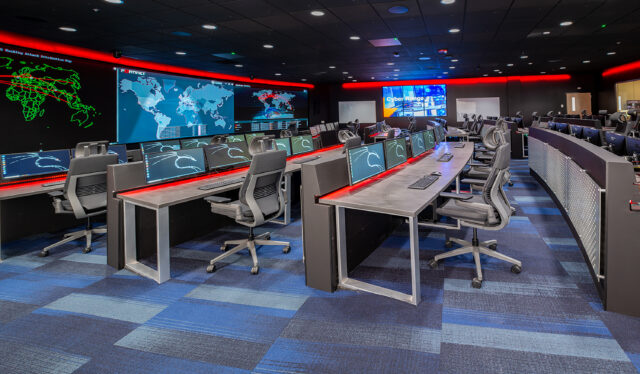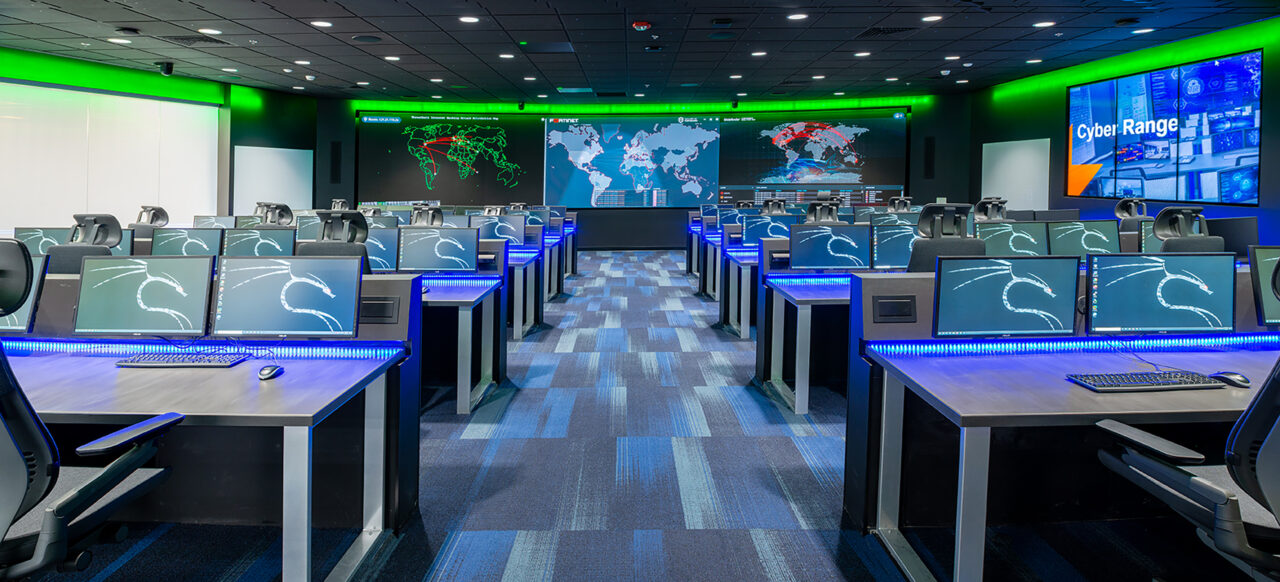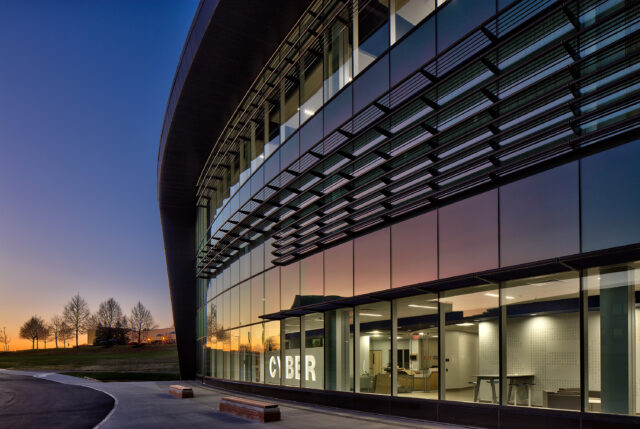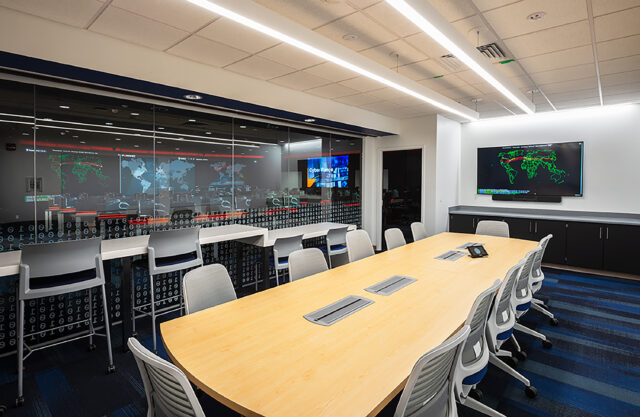Lessons Learned at EDspaces 2023

In November 2023, members of our K-12 and Higher Education studios traveled to Charlotte, North Carolina for EDspaces, an annual conference that explores how schools and educational campuses can better serve pedagogical needs and student success. The 2023 conference featured an expansive showroom of educational furniture and technology solutions, local facility tours, and a wide range of educational sessions to further attendees’ knowledge of how space impacts learning.
Additionally, LaBella’s Senior Interior Designer Danielle Lewis, CID, IIDA, WELL AP, and Higher Education Studio Manager Jerry DeRomanis, AIA, joined Chad Weeden, Director of Esports and CyberSecurity Range at Rochester Institute of Technology (RIT), to present “Decoding Cybersecurity,” a discussion of immersive learning environments through the lens of RIT’s ESL Global Cybersecurity Institute.
Agency-Rich Environments
Over the past several years, conference themes have been focused on student mental health and well-being, diversity and inclusion, and student involvement in design, as well as emerging trends in education such as makerspaces or esports. While these topics were ever-present at the 2023 EDspaces conference, an overarching topic of “agency-rich environments” guided the direction of this week-long event. Tom Vander Ark, CEO of Getting Smart, kicked off EDspaces by presenting this idea at the plenary keynote session. Agency, he explained, refers to the ability of students to act with autonomy as well as advocate for themselves in how they interact and learn.
As educators and designers know, not all students learn in the same way, but many learning environments have stayed static in design and use since the industrial era. These traditional learning environments favor teacher-centric, lecture-focused styles of learning. However, many psychologists and learning theorists, such as Howard Gardner, have shown that students learn best in a variety of ways. Gardner’s theory of multiple intelligence suggests that learners have a wide range of abilities and are stronger in certain ones than in others. Of his eight “intelligences,” traditional learning environments cater toward verbal and linguistic learners, who can easily remember written or spoken information.
However, as Vander Ark would likely agree, students need spaces and instruction that support a variety of learning styles. His talk delved into the importance of allowing students to take ownership over how they learn through five key building blocks: creating projects, having a solid advisory system, utilizing extended learning, having personalized blends of instruction, and participating in immersive experiences. These components promote a sense of curiosity and encourage students to conduct their own research, collaborate with others, and present and reflect on their findings. Traditional learning environments, as described above, struggle to effectively support this next generation of teaching and learning.
Creating Effective Learning Spaces
So, what kinds of spaces and what design elements create an effective learning environment? The short answer is that a variety of flexible and adaptable spaces allows students to choose and shape the environments they’re learning in.
As always, the EDspaces showroom floor featured a diverse range of furniture solutions that promote these concepts through student movement, collaboration, and ergonomics. Several pieces focused on tactile elements to benefit Gardner’s kinesthetic and movement-based learners. Furniture that provides acoustic isolation while allowing for visual access supports introverted and intrapersonal learners who need space for solo reflection. Easily movable and reconfigurable items allow interpersonal learners to rearrange space to support large group discussions and collaboration. These simple affordances give students the autonomy to make decisions that best support their needs.
Aside from these tangible furniture options, several conference education sessions touched on the idea of student agency through immersive learning experiences. This type of teaching and learning is heavily student-centric and hands-on, much like the concept of project-based learning. Similarly, where traditional environments focus on the teacher as the source and distributor of knowledge, immersive learning environments (ILEs) understand that teachers should be guides or advisors rather than the single source of information. What differentiates an ILE from any other space supporting project-based learning is that the environment and/or technology used within it replicates real-world scenarios in an educational setting. This method provides a low-risk but highly effective setting for students to apply the knowledge they’ve learned to simulated situations.
ILEs are particularly prevalent in spaces like nursing school environments where hyper-realistic technology, such as virtual reality and simulative environments, prepare students for the healthcare field; in esports facilities where athletes compete in realistic arenas and “shoutcasters” produce live broadcasts; or in Career and Technical Education (CTE) programs where students use professional equipment to understand how to produce and service practical items and systems. These environments greatly benefit interpersonal and social learners who thrive from interaction and discussion, visual and spatial learners who learn best by seeing examples, and bodily or kinesthetic learners who understand deeply by experience, among others. The 2023 EDspaces conference had several discussions on these types of spaces, detailing the benefits of immersive learning as well as best practices to implement supportive space design.
LaBella at EDspaces
LaBella’s own presentation, “Decoding Cybersecurity,” explored how the concept of ILEs was applied to RIT’s ESL Global Cybersecurity Institute, an addition to the Golisano College of Computing and Information Sciences completed in 2020. This 52,000-square-foot facility is home to multiple computer training labs, research facilities, faculty and student spaces, and the Eaton Cyber Security Range (pictured below). This space, at the heart of the building, epitomizes the concept of an ILE, acting as a sort of “mission control” for cybersecurity education. The space also serves as an arena for the college’s esports team and curriculum, allowing for multipurpose use despite a highly tailored design.

This collaborative simulation environment replicates real-world command centers that students can expect to work in and features immersive elements that engage students’ senses to replicate realistic and often high-stress scenarios. Technology such as a 38-foot, 4K video wall paired with a state-of-the-art remote control system allows the instructor and students to cast information from any computer or location in the room to the main screen. RGB-capable LED lights are included in the ceiling and within the custom workstations to convey different levels of complexity or mood (green may indicate an easy task, while red implies a stressful or complex scenario). Under-mounted bass transducers at the desks and easily programmable HVAC controls give an opportunity for 4D experiences to simulate cyber and physical attacks where the desks can vibrate and the room temperature can increase to induce anxiety.
All of this is not to torment students, but rather to better prepare them for the types of scenarios and emotions they may experience upon entering the profession. As a few presenters discussed, these ideas are found in nursing simulation labs where high-tech mannequins outfitted with microphones and speakers allow instructors to simulate patients in distress and see how students react and apply their skills.
These ILEs and experiences also emphasize the importance of student agency by giving students the opportunity to synthesize and test what they’ve learned. While not every school or space can be outfitted with such extensive technology, strategically designed, multipurpose spaces or supportive technology can enhance the ways our students interact with space, one another, and learning. Whether it’s providing ways for students to customize their environments through furniture and writable surfaces or allowing space for project-based and immersive learning, the key takeaways underscore the significance of giving students a sense of agency in shaping the future of education.



About the Author
Danielle Lewis, CID, IIDA, WELL APSenior Interior Designer
Danielle is a Certified Interior Designer and WELL Accredited Professional with a focus on K-12 and higher education projects. She recognizes trends in pedagogy that cross over from both markets and strives to create spaces that prepare learners for graduation and beyond. Danielle is passionate about designing learning environments that enhance student success, joy, and well-being, and believes that the best designs stem from engaging with stakeholders early in the process to craft solutions that capture the clients’ visions and goals.